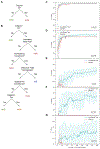Context-Dependent Learning of Linguistic Disjunction
- PMID: 36353801
- PMCID: PMC12039866
- DOI: 10.1017/S0305000922000502
Context-Dependent Learning of Linguistic Disjunction
Abstract
What are the constraints, cues, and mechanisms that help learners create successful word-meaning mappings? This study takes up linguistic disjunction and looks at cues and mechanisms that can help children learn the meaning of or. We first used a large corpus of parent-child interactions to collect statistics on or uses. Children started producing or between 18-30 months and by 42 months, their rate of production reached a plateau. Second, we annotated for the interpretation of disjunction in child-directed speech. Parents used or mostly as exclusive disjunction, typically accompanied by rise-fall intonation and logically inconsistent disjuncts. But when these two cues were absent, disjunction was generally not exclusive. Our computational modeling suggests that an ideal learner could successfully interpret an English disjunction (as exclusive or not) by mapping forms to meanings after partitioning the input according to the intonational and logical cues available in child-directed speech.
Keywords: Disjunction; Language Acquisition; Language Development; Logical Words.
Conflict of interest statement
Competing interests: The author(s) declare none.
Figures
















References
-
- Aloni M (2016). Disjunction. In Zalta EN (Ed.), The Stanford encyclopedia of philosophy. Stanford University. Retrieved from https://plato.stanford.edu/archives/win2016/entries/disjunction/
-
- Baldwin D (1993). Infants’ ability to consult the speaker for clues to word reference. Journal of Child Language, 20 (2), 395–418. - PubMed
-
- Braine MD, & Rumain B (1981). Development of comprehension of “or”: Evidence for a sequence of competencies. Journal of Experimental Child Psychology, 31 (1), 46–70.
-
- Breiman L (2001). Random forests. Machine Learning, 45 (1), 5–32.
-
- Breiman L (2017). Classification and regression trees. London: Routledge.
MeSH terms
Grants and funding
LinkOut - more resources
Full Text Sources

